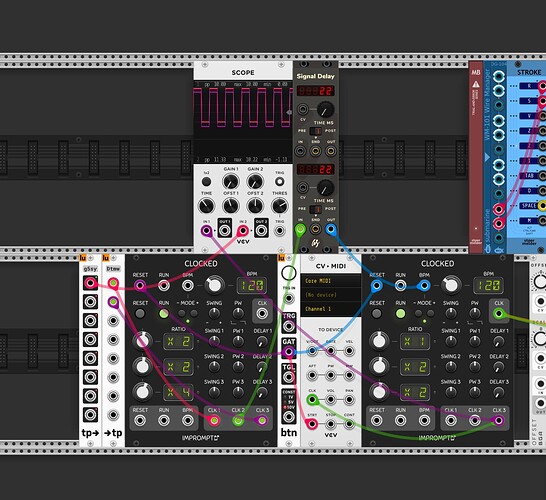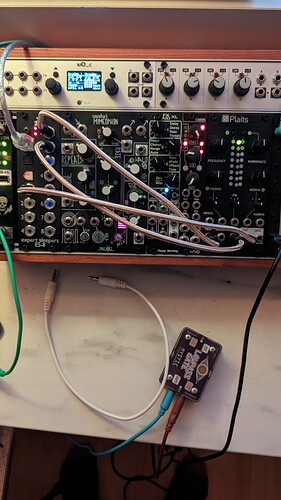I think some of the Presonus interfaces have DC coupled sockets, check the specs.
Expert sleepers dedicated support and regular feature updates openly discussed on modwiggler is worth considering.
Hi, I use the ES-9 with my setup which consists of a full 2 racks of AE Modular, a MOOG DFAM and Subharmonicon, VCV Rack, and Bitwig Studio. I also use a Beatstep Pro and a AKAI MPK225. My laptop runs Linux/Kubuntu/UbuntuStudio and uses the Jack Audio system. I can route everything to everything using this setup.
The ES-9 is great because I can send CV to and from my modular/semi-modular stuff and my DAW and VCV Rack. I don’t experience any noticable latency. It was hard to figure out how to configure the ins and outs on the ES-9 at first, but after a little reading and experimentation I got it working the way I wanted it to.
I also use it some with Windows 11 and Ableton Live 10 and Bitwig Studio as well as VCV Rack, with the same great results, though it needs a driver for Windows.
I had a real hard time locating one to buy at the beginning of January. I live in Colorado and the only place I could find one was Blickin Synths in the UK. But he shipped it via DHL and it got to me in less than 72 hours.
I’m really happy with mine.
You don’t have to change the source code… just send a 1kHz (or whatever frequency you want) oscillator into the TRIG input.
Hello, I have been looking into buying the ES-9 as well. But I was put off by people complaining about it’s latency. So I went for PreSonus studio 1824c which has DC-coupled outputs. It doesn’t have any noticeable lag providing control voltages - only they aren’t the same values as shown by the outputs in VCV Rack 2 Pro. Are there any settings I need to adjust so the outputs of the audio interface match those in VCV Rack, or can this only be achieved with dedicated MIDI-to-CV interfaces?
Thanks for your help!
Cheers,
Dirk
18 dBu max output according to tech sheet, equals 8.7V peak. (I used this converson tool)
10V CV on the VCV audio module outputs sets “all bits to high” and gives +8.7V on the interface. Use a multimeter if you need to know the exact value - and a DC amplifier/multiplier (A*B+C) like Befaco A*B+C if you need to scale it to +/-10V.
The midi-to.CV interfaces often output full eurorack range -10 to 10 V, some do -3 to +7V, some only 7 bit resolution, some 14bit.
The Expert Sleepers ES-9 and ES-3(I have one of these) are DC coupled audio cards, that have calibrated (not) -10 to +10V outputs.
You can use a module like VCV Library - Bark Clamp or VCV Library - Befaco A*B+C etc. to do the conversion.
Thunator might come in handy also.
That’s fast, precise and complete guide - many thanks! I did compare voltages of gate on/off and pitch coming from 1. Arturia Keystep 37’s CV outputs and 2. One of the audio interface. Pitch was way off by both an offset and then scaled. With the tools you linked I should be able to tweak until the voltages match. I wonder if the Expert Sleepers really have so much lag or if the cases I came across were user errors or due to older firmware or bad settings. And I wonder how the Polyend - Poly 2 compare regarding latency.
Btw, I love Denmark ![]()
The lag/latency depends of the buffer settings in the OS - like any other audio I/O device. this is true for the Expert Sleeper cards ES-9/ ES-3 at least (2ms - 30 ms latency depending on various settings).
I guessed that this could be due to settings, so the audio DC-coupled audio interface solution is not necessarily the faster one, as I guessed. Maybe I should have asked in this forum before I bought the gear, duh. I’ll get an ES-3 like you, a Polyend Poly or a Mutant Brain sometime in the future I guess. Any preference here? I don’t need many gate/trigger-channels, but more freely assignable CV-outs per channel.
Depends … I’m happy with the old ES-3, it connects using ADAT to a Behringer UMX1820 here. But i haven’t looked - maybe ADAT Lightpipe is finally dead now.
The must fun i think is to DIY a microcontroller with a good DAC, at least 16 bit, and some MUXes + sample and hold for analog outputs. With cvOSCcv, you can have a bunch of analog outputs for little money. (one can look in the schematic for a moog slimphatty to see how DAC/MUX/S&H can be done.)
Awesome! Didn’t know about this option, nice little rabbit hole. Going to peek into it.
By regaining trust in Expert Sleepers concerning lag, I looked up their product line again and found that the FH-2 should be the perfect solution for me and also helps shrinking my setup. I just found one on ebay in the U.K. for 265€ incl. shipping. Retailing 335€ in shops here in Germany. Thanks for the info about the lag. I can use my audio interface again for audio, too XD. Although these DIY projects are interesting, the ES FH-2 looks like a quick and solid solution for me now.
Just found a nice thread about the topic:
I use an ES-8 (with ES-6 and ES-3 attached via light pipe) as an interface.
After a variety of approaches, this year I finally feel like I solved my sync issues with external gear using the same method that @ LarsBjerregaard suggests in there (wish I’d found that discussion before, full of good ideas!).
I find that, at 48khz samplerate (the highest that the ES-6 and ES-3 seem to easily support, unfortunately), at Block Size: 256, I need to do a 22 millisecond delay to have my internal clock in sync with the external clock.
After that everything’s great. Very nice to have everything in sync. I think, after trying lots of other less effective methods, this one works perfectly.
Oh, I run that clock signal out into an external Marbles, which syncs to it nicely, and also allows me to do different clock multiples or divisions externally if I want.
For additional ins and outs, I have a Presonus Quantum that I use, and turned them into an Aggregate Device in MacOS with the ES-8.
Here you can see the aggregate device, and the Expert Sleepers modules I’ve used to calibrate five each of the ES-8 inputs and outputs.
That’s my little breakout panel for the Quantum to the left of the expert sleepers devices.
All in all, it’s a bit of overkill, and sometimes the aggregate device gives me a headache that requires closing and opening VCV and toggling power on the ES-8 a few times, but it works so well that, other than that, I basically never need to redo all the work whenever I want to get a bunch of signals in and out of the computer.
And if I need to get extra low latency, for like, guitar input or something, I can use the quantum on its own at whatever samplerate I want.
Nice breakout panel and all! Thanks for the screenshots. I like the Expert Sleepers module plugins in VCV.
When using my audio interface PreSonus Studio1824c in VCV Rack only I could dial down the buffer size and use the interface for both audio input from a Eurorack module (PLONK in this case) as well as trigger and pitch control it from one of its outputs with hardly any noticeable lag at all from keypress to ear. Problems showed up when I tried running VCV Rack as a plugin in FL Studio. Normally FLStudio uses the ASIO driver from PreSonus and VCV rack just communicates with the DAW it is hosted in. Now I needed to get signals out of the ‘nested’ VCV Rack and back in. Seems to me they don’t seem to like sharing the same driver of the audio interface or something. VCV Rack crashes sometimes and with it FL Studio 21, or I cant get audio in and out and the pulse of the ping is also heard in the speaker because it’s been routed by the DAW also and sent to OUT 1-2 … So I tried using the PreSonus interface only in VCV Rack for sending CV to a EuroRack module. The DAW in which VCV Rack was running as a VST plugin was using another audio device to receive the audio in the DAW, a MOTU M4 which is about as fast as the PreSonus one. Unfortunately, this solution had a lag of somewhere around 25ms - I wish it was shorter. I hope the FH-2 from Expert Sleepers will be faster, and also since it being a midi and not an audio device, I also expect less issues like the one I had with running VCV Rack in a DAW ( DAW and VCV Rack needing full access to the same audio interface - vs - CV being controlled through midi channels via ES FH-2, separated from audio ). I also tried running FL Studio as a plugin in a host module in VCV Rack which seemed to work ok, but I prefer the other way around.
I’ll let you know if the ES FH-2 is any faster once it’s in the mail.
I have had no noticible issues with my es-8 in 18 months of owning it. I send pitches and they seem calibrated fine without the use of the silent way plugin and needing to send audio back in and all that.
How about lag and did you run VCV rack also as a VST-plugin in a DAW, while sharing the ES-8 between VCV-Rack2 plugin and DAW?
no daw, just vcv stand alone.
what i’ve done as a test is a sequence in vcv. Pitch + gate go to Plaits and also to audio 16, connected to ES-8 and then patched to physical plaits.
Both plaits play the same sequence at the same time.
The ES-8 is definitely not hardware calibrated so you might just be exceptionally lucky that all? the outs on yours are accurate enough for pitch work without using the silent way modules. Or maybe you have terrible ears haha ![]()
Huh, now I’m curious if I got lucky or if my ears suck. Either way, it’s close enough for me ![]()



